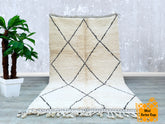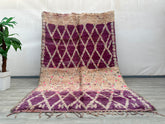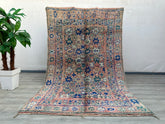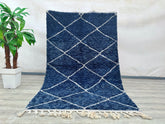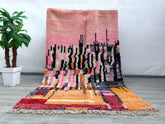Traditional and modern Berber carpets
The Origins of the Berber Carpet: A Journey to the Paleolithic Era
The roots of Berber carpets trace back to the Paleolithic era, marking centuries of tradition woven into these unique works of art. Passed down from generation to generation, the techniques of traditional Berber carpet weaving remain unchanged. Each pattern and design tells a story, drawing from symbols rooted in Berber beliefs, religion, and cultural heritage. These carpets aren’t just functional items; they’re expressions of a way of life that has been preserved even as modern influences and the shift of nomadic tribes to settled lifestyles began to change traditional practices.
Symbolic Berber Designs: An Artful Expression of Culture
Each Berber carpet is not only woven but also layered with meaning. Patterns and symbols reflect beliefs, stories, and the essence of Berber culture. These artistic representations vary across tribes, where unique designs serve as markers of identity. The deep significance of these symbols has helped Berber carpets endure as culturally significant pieces of art, treasured within homes for generations.
The Threat to Berber Carpet Traditions
Despite their cultural importance, the traditions surrounding Berber carpets are at risk. Modernization and the decline of nomadic lifestyles threaten the continuity of these ancient practices. However, there’s also a revival underway, with new materials and expressions reintroducing Berber carpets to a broader audience, ensuring their legacy remains alive.
Berber Rugs and Wedding Dowries: A Heritage of Wealth
In Berber tradition, young women often weave carpets as part of their wedding dowry, making these pieces not just household items but symbols of wealth and family heritage. Due to their economic value, these carpets are cherished by families and used sparingly. Selling a carpet often happens only during times of financial need, making each piece a valuable asset .
Materials and Types of Wool Berber Rugs
Traditionally, Berber rugs are crafted from wool, with the most common types being Beni Ouarain and Azilal carpets. Beni Ouarain carpets feature black geometric patterns on a white wool base, providing a luxurious, thick feel. Meanwhile, Azilal rugs are more colorful, reflecting the vibrant spirit of the region. For families with limited resources, Boucherouite carpets emerged in the 20th century, made from recycled materials, showing creativity in resourcefulness .
Traditional and Modern Berber Rugs in North Africa
Traditional Berber rugs remain a staple in North Africa, while modern Berber rugs have evolved, blending the essence of Berber design with updated styles. Today’s Berber rugs often use ring piles that mimic traditional knots, featuring neutral tones with subtle patterns. Although less expensive, these modern rugs maintain Berber elegance, while traditional handmade rugs showcase brighter colors and intricate designs.
Handmade Berber Rugs: A Vital Industry in Rural Areas
In rural Berber regions, rug-making remains a vital source of income for families. Artisans sell their handwoven carpets in local markets, sustaining the family economy while preserving ancient traditions. Handmade Berber carpets stand out from mass-produced versions, offering authenticity and individuality that resonates with admirers and collectors.
Berber Carpet Materials: Wool vs. Synthetic
With modern Berber rugs, materials have diversified to include nylon, olefin fibers, and wool. Wool remains a popular choice for its softness and resilience, while synthetic options like olefin offer affordability and resistance. Each material serves different needs, allowing Berber carpets to appeal to various tastes and preferences.
Berber Carpet Care: Tips for Cleaning and Maintenance
Berber carpets are known for their durability and stain resistance, making them ideal for various settings. To maintain them, experts recommend a dry-cleaning method or low-humidity cleaning. Steam cleaning should be done with care, as alkaline cleaners can damage olefin-based carpets. For best results, a deep cleaning is advised every six months to a year, depending on usage.
Berber Carpets for Sale: Choosing Authenticity and Quality
When purchasing a Berber carpet, it’s important to recognize the value of handmade authenticity. Traditional Berber carpets carry the heritage and craftsmanship of Berber tribes, while modern Berber options offer a similar aesthetic at a more affordable price. Knowing the difference between wool and synthetic fibers, as well as the variations in design, ensures that your Berber carpet selection brings both beauty and lasting quality to your space.
Featured Products
155 x 247 cm = 5.1 x 8.1 ft Diamonds Blue Soft Dots Berber Runner Rug - Handmade Moroccan Wool, Minimalist Design, Vintage Style, Perfect for Weddings & Bohemian Decor
- $599.00
$1,830.00- $599.00
- (-67%)
- Unit price
- / per
171 x 279 cm = 5.6 x 9.2 ft Colorful Abstract Moroccan Runner Rug - Handmade Berber Wool, Minimalist Design, Vintage Bohemian Style, Perfect for Weddings & Decor
- $599.00
$1,830.00- $599.00
- (-67%)
- Unit price
- / per
- Authentic Moroccan rug
- Beni Ourain
- Beni Ourain rug
- Beniouraincarpets
- Berber rug history
- bohemian rug moroccan rug
- Custom Moroccan Rugs
- Hand-woven rugs
- Handmade carpet
- Handmade rug imperfections
- Luxury home decor
- modern moroccan rug
- Moroccan Berber rug
- Moroccan home décor
- Moroccan rug
- Moroccan rug buying guide
- morrocan rug
- Natural fiber rugs
- Plush area rug
- Plush texture rugs
- Rug craftsmanship
- Rug interior alignment
- Timeless rug designs
- Traditional rug design
- white beni ourain
- White wool rug


